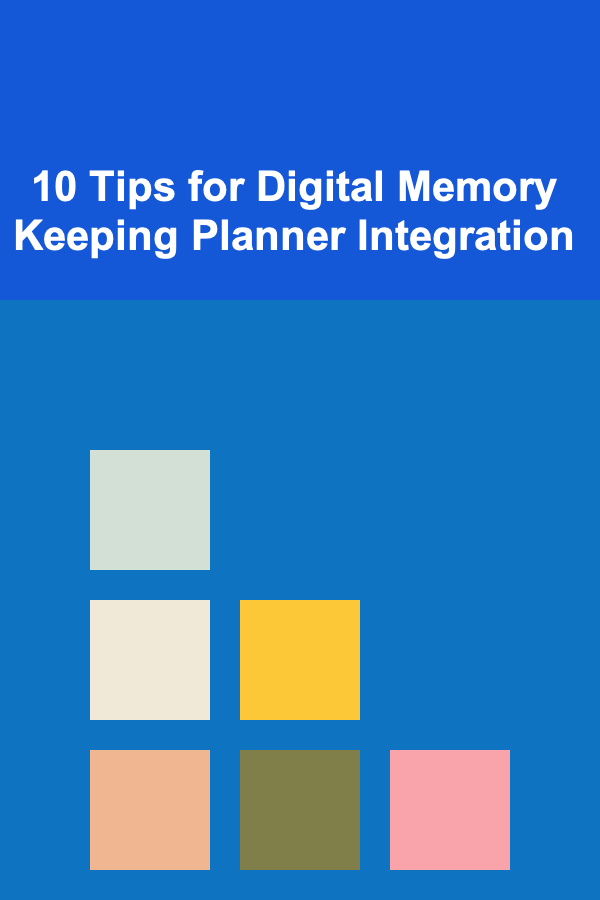
10 Tips for Digital Memory Keeping Planner Integration
ebook include PDF & Audio bundle (Micro Guide)
$12.99$8.99
Limited Time Offer! Order within the next:

In today's fast-paced world, digital tools have revolutionized how we organize, plan, and record our lives. Among these tools, digital planners and memory-keeping apps stand out, offering new ways to document and reflect on personal milestones, daily events, and creative journeys. Memory keeping, once dominated by traditional scrapbooking, has evolved into a digital format that offers greater accessibility, flexibility, and creativity.
Digital memory keeping allows individuals to combine elements of journaling, photography, art, and organization into one seamless digital experience. With an increasing number of digital planners, apps, and tools available, integrating memory-keeping strategies into a planner can make the process more enjoyable, productive, and visually appealing. This article will explore 10 tips for seamlessly integrating memory-keeping into a digital planner, helping you preserve memories while maintaining an organized, structured life.
Choose the Right Digital Planner
Before diving into memory-keeping, selecting a digital planner that suits your needs is essential. There are numerous digital planners available, each offering various features and layouts to cater to different preferences. Popular platforms such as GoodNotes, Notability, and Evernote offer customizable planners that can integrate with memory-keeping practices.
When choosing a planner, consider the following factors:
- Compatibility: Ensure that the planner is compatible with your devices (iOS, Android, or tablet).
- Flexibility: Look for planners that offer customizable layouts for various purposes---daily planning, journaling, memory keeping, etc.
- User Experience: A planner should be easy to navigate, visually appealing, and user-friendly to encourage consistency in use.
- Memory-Keeping Features: Some digital planners are designed specifically for memory keeping, offering features such as photo inserts, journaling spaces, and scrapbooking templates.
Once you've selected your ideal digital planner, it's time to make it work for you in the context of memory keeping.
Utilize Digital Stickers and Templates
Digital stickers and templates are excellent tools for adding creativity and visual appeal to your memory-keeping process. These pre-made graphics and design elements can enhance the aesthetic of your planner and help you tell your story in a visually captivating way.
- Stickers: Digital stickers allow you to decorate your planner pages with thematic designs. Stickers could include icons, illustrations, quotes, or decorative elements that align with the mood or theme of the memory you're documenting.
- Templates: Many digital planners offer pre-designed templates for journaling, scrapbooking, or memory pages. Templates save time and effort while providing a structure for your entries.
Many websites and apps, such as Etsy or Pinterest, offer downloadable sticker packs and templates that can be integrated into your digital planner. Use these to create unique memory pages that stand out and personalize your entries.
Create a Dedicated Memory-Keeping Section
One of the easiest ways to integrate memory keeping into your digital planner is to dedicate a section specifically for this purpose. By creating a memory or journaling section, you ensure that all your thoughts, experiences, and photos are kept together in one easily accessible location.
You could divide this section into different categories:
- Daily Highlights: Record one or two things that stood out each day. These could be emotional moments, accomplishments, or even challenges that you overcame.
- Special Events: Create pages for birthdays, vacations, holidays, or other significant events, adding photos, tickets, and personal reflections.
- Creative Projects: Document your creative processes---art, writing, photography, or DIY projects---and keep track of your progress.
Using tabs or hyperlinks, you can quickly navigate between sections for easy access to your memories.
Add Photos and Visual Elements
One of the most powerful features of digital memory keeping is the ability to easily add photos and visual elements. Unlike traditional scrapbooking, where printing and cutting are required, digital platforms allow you to import, resize, and arrange photos with ease.
Incorporating photos into your memory pages can be done in a few creative ways:
- Daily Photo Entries: Consider adding a photo each day that represents your experience. This could be a snapshot of your day, a place you visited, or a picture with loved ones.
- Themed Memory Pages: Create themed pages for specific events, trips, or milestones. Use multiple photos to create a collage or scrapbook effect.
- Before-and-After Shots: Document progress on long-term projects or personal goals by including before-and-after photos, which can visually showcase your journey.
With digital planners, you have the flexibility to use various photo-editing tools to adjust the brightness, contrast, or crop photos before inserting them into your planner, ensuring that they complement the overall design of the page.
Incorporate Journaling and Writing
Journaling is an essential part of memory keeping, as it adds a personal touch to your digital planner. Writing allows you to reflect on your experiences and emotions, providing context to the photos and visual elements you add.
Incorporating journaling into your digital planner is simple, as most platforms support freeform text entries, which can be formatted and styled. Here are some ways to use journaling effectively:
- Daily Reflections: Write a brief summary of the day's events, highlighting key moments or your emotional state.
- Event Recaps: For special occasions or trips, create detailed journal entries that describe your experience in-depth, adding context to your photos and mementos.
- Gratitude Journals: Write a few things you're grateful for each day or week to reflect on positive experiences and moments of appreciation.
Digital planners often allow you to use different font styles, colors, and sizes, helping you personalize your journal entries and make them visually appealing.
Leverage Color Coding for Memory Categories
Just like physical planners, color coding is a great way to visually organize your memory-keeping entries in a digital planner. By using different colors for specific memory categories, you can easily identify and navigate to particular types of memories.
- Family Memories: Use a soft blue or pastel color for family-related entries, such as birthdays, holidays, and family outings.
- Travel Diaries: Use a green or earth-tone color to denote travel-related memories, such as vacations, road trips, or weekend getaways.
- Creative Projects: Highlight personal projects, such as art, writing, or DIY, with a bold or creative color like yellow or purple.
Color coding allows you to quickly identify and reference different types of memories in your planner, adding a sense of order and clarity to your digital scrapbook.
Set Reminders to Document Daily Memories
Digital planners often have reminder features that can help you stay on track with your memory-keeping. Setting daily or weekly reminders to jot down memories, upload photos, or reflect on your day ensures that you don't miss important moments.
Consistency is key to effective memory keeping, so by scheduling regular reminders, you can create a routine that supports your memory-keeping habit. Whether it's a quick note, a photo upload, or a full journal entry, these reminders will encourage you to engage with your planner and document life as it happens.
Use Audio and Voice Notes for Memory Keeping
Not all memories can be captured with photos or writing alone. Sometimes, your thoughts, feelings, or the sounds of an event can add depth and authenticity to your memory-keeping experience. Digital planners often support the integration of voice recordings and audio notes.
- Audio Reflections: Record your voice to capture your immediate thoughts or reflections about an event or day. This can provide a richer memory when revisited later.
- Event Sounds: Record sounds during events, such as laughter, music, or even ambient noises, to add another sensory layer to your memories.
Integrating audio elements in your digital planner creates multi-dimensional memories, offering a more immersive experience when you revisit them later.
Sync Across Devices
One of the advantages of digital planners is that they can sync across multiple devices. Whether you use a tablet, smartphone, or desktop, syncing ensures that your memory-keeping efforts are always up-to-date and accessible from anywhere.
This is especially useful for capturing on-the-go memories. For example, if you're out for a walk and see something beautiful, you can quickly snap a photo and add it to your planner right away, knowing it will sync across all your devices for easy access later.
Make sure to enable syncing features in your digital planner to ensure that your memory-keeping remains consistent across devices.
Create a Yearly Recap or Memory Book
At the end of the year, you can take all the memories you've documented and create a yearly recap or digital memory book. This recap can include a compilation of your favorite photos, journal entries, events, and reflections from the year.
Many digital planners and apps offer the ability to export your pages or create digital photo books. Use these features to create a printable or shareable memory book that serves as a summary of the year's most important moments. This digital scrapbook can then be shared with family, friends, or preserved for personal reflection.
Conclusion
Integrating memory keeping into your digital planner is a creative and efficient way to document your life's experiences. With the right tools, thoughtful organization, and consistent effort, you can turn your digital planner into a rich, multi-layered scrapbook that preserves memories in a modern, accessible format.
By selecting the right planner, using creative elements like stickers and templates, adding photos, journaling regularly, and leveraging digital features, you can make memory-keeping a meaningful part of your daily planning process. Whether you are recording daily moments, special events, or personal growth, digital memory keeping offers a dynamic way to preserve your memories for years to come.
Reading More From Our Other Websites
- [Organization Tip 101] How to Utilize Over-the-Door Organizers in Your Bathroom
- [Home Renovating 101] How to Update Your Home's Entryway for a Welcoming Feel
- [Survival Kit 101] Best Survival Kit for Sustainable Living: Eco‑Friendly Materials and Reusable Items
- [Paragliding Tip 101] Budget-Friendly Picks: Best Paragliding Harnesses Under $500 Reviewed
- [Home Party Planning 101] How to Collaborate with Friends for a Potluck Party
- [Home Cleaning 101] How to Use Essential Oils in Your Cleaning Routine
- [Tie-Dyeing Tip 101] How to Use Tie‑Dye to Upcycle Vintage T‑Shirts into Modern Art Pieces
- [Personal Care Tips 101] How to Choose a Face Mask That Fits Your Skincare Needs
- [Personal Care Tips 101] How to Select an Eye Cream for Dark Circles Under Eyes
- [Personal Care Tips 101] How to Adjust Your Acne Treatment Cream for Seasonal Changes in Your Skin

How to Maintain Your Home's Paint and Finish for Longevity
Read More
How to Organize a Small Dining Area for Functionality
Read More
How to Understand Penetration Testing Basics
Read More
How to Adapt Your Classroom Planner for Hybrid Learning
Read More
10 Tips for Restoring Antique Silverware
Read More
10 Tips for Gratitude Journaling
Read MoreOther Products

How to Maintain Your Home's Paint and Finish for Longevity
Read More
How to Organize a Small Dining Area for Functionality
Read More
How to Understand Penetration Testing Basics
Read More
How to Adapt Your Classroom Planner for Hybrid Learning
Read More
10 Tips for Restoring Antique Silverware
Read More